Around the World in (less than) Six Minutes
by Dave and Noelle
As shiny as a precious gem, Cartagena shimmers on Colombia’s Caribbean coast, a beacon of the country’s recent progression.
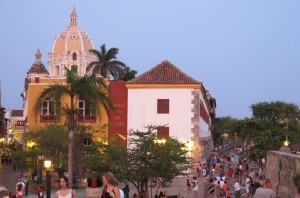 Founded in 1533 by a Spanish explorer (and as it turns out, an enterprising pirate), the town soon became a hideaway for all the booty the conquerors stole from the continent. The mounds of shineys naturally drew the attention of women everywhere other thieves and pirates, so the settlers – finding no other solution to protecting their loot – eventually built the town’s impressive fortified walls in the 17th century that still stand today. The colonial-styled city within the walls is a UNESCO World Heritage Site – our last and millionth (legal disclaimer: perhaps a slight exaggeration…but really? Only slight.) UNESCO-designated site visit of the trip.
Founded in 1533 by a Spanish explorer (and as it turns out, an enterprising pirate), the town soon became a hideaway for all the booty the conquerors stole from the continent. The mounds of shineys naturally drew the attention of women everywhere other thieves and pirates, so the settlers – finding no other solution to protecting their loot – eventually built the town’s impressive fortified walls in the 17th century that still stand today. The colonial-styled city within the walls is a UNESCO World Heritage Site – our last and millionth (legal disclaimer: perhaps a slight exaggeration…but really? Only slight.) UNESCO-designated site visit of the trip.
And, while diamonds may be Marilyn Monroe’s (and probably the pirate’s) BFF choice, Cartagena brings serious competition. Also like the coveted jewel, it comes with it’s own set of 4 C’s.
From the moment we stepped off the plane, the heat of this coastal town knocked us off our jean-clad feet. Cartagena’s average daily temperature is 80 degrees. ALL. YEAR. LONG. So, immediately upon arrival at our apartment in El Laguito (the southwestern most neighborhood perched at the end of the city’s skinny hangnail peninsula), we traded our jeans for our bathing suits and hit the rooftop pool overlooking Cartagena Bay.
We found a few other tricks to escape the heat – mainly by seeking bodies of water, sipping cool cocktails or making our way through the maze of narrow, cobbled and most importantly, shaded streets of the city’s Old Town in search of air-conditioning. Our first score came in the form of Abaco Libros, a bookshop/café serving up a Cartagena classic, limonada de coco. This frozen lemonade with a touch of coconut tastes like an icy piña colada and is a perfect antidote to the sweltering heat.
Those looking to score a break from the stifling heat can also hit the walls. A stroll atop the two mile stretch of 400-year old stone walls is not only a powerful historical experience, but provides an excellent breeze off the crystalline waters. And if the breeze dies off, you can always stop off at Café del Mar and surrender to the heat with a cold beer among the canons.
Sitting outside at night can be another way to casually cool off. On the recommendation of our friends Paige and Eric, who lived here for two years and were a wealth of knowledge (seriously, we followed their list of recommendations like you follow an IKEA instructions manual…if you’ve ever put something from there together, you get what I’m talking about – you don’t veer from that sh*t.), we headed to Plaza Santo Domingo and snagged a seat at a table out in the square. Within minutes we had a bottle of Ron Medellin (the rum of choice and unbeatable in price) and a couple of coca cola lights, spending the next two hours sipping on cuba libres and people watching.
And if all else fails, head to the Hilton Hotel and cut through the lobby to the pool in the back. American families living in Cartagena use the hotel like a country club, so no one even looked our way as we strolled through the lobby (despite the elaborate story we’d spent the last hour preparing…in Spanish). We spent our last afternoon basking in the Colombian sun, surrounded by a clientele that made it easy to mistake our location for SoCal.
The historic heart and soul of this city lies in its maze of cobbled calles (streets) and the charming, brightly colored buildings that line them. Mainly colonial style, the color palate of the buildings that crowd Old Town shifts and shimmers from ochre to blood red and blue to gold. With a grid-like system and a walled perimeter, you can confidently get lost for hours among the horse-drawn carriages, friendly street vendors and boutique shops knowing you’ll eventually wander your way out.
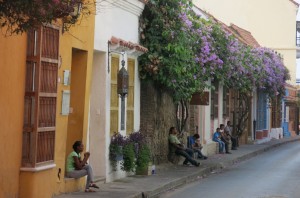
Narrow and winding streets, cluttered with pastel-painted balconies, suspend time in this historic gem.
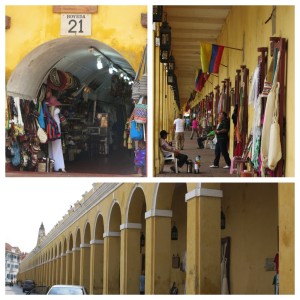
The shops of Las Bovedas are housed in an old dungeon attached to the city walls, the former cells used to sell traditional Colombian merchandise.
Equally as atmospheric is the working-class neighborhood of Getsemaní, where we spent our final nights in Cartagena. Better bargains (for both accommodations and food), this neighborhood was the place to be to really feel (and taste) the flavor of the city. We spent the evenings mingling with Cartagenans in the local square and in the streets enjoying the cool night air.
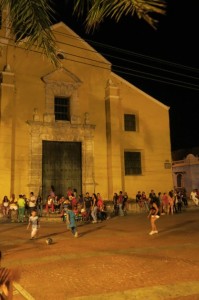
We stumbled upon Getsemaní Square, cluttered with local kids playing soccer. Dave insisted he’d have dominated if he joined in. I reminded him they were 7.
One of the most wonderful things about the city is its proximity to the beautiful, rippling Caribbean waters. The coast frames the city, creating a playground for children and adults to sun their bodies, frolic in the water, take in a stunning sunset, enjoy a dinner al fresco or merely stroll the languid stretch of white sand.
After a week in Cartagena, we decided to explore more of this beautiful coastline by heading 5 hours northeast to the port city of Santa Marta. The first Spanish settlement in Colombia, it lays claim as the oldest surviving city in the country, and wears its much-earned dilapidation with pride. We spent three nights in the lackadaisical town, which more than outstayed our welcome. As a destination to slow down, eat good food and visit beaches, Santa Marta was an excellent choice. But as far as things to see, the choices are limited. Add to that the gale force winds (merchandised as “peaceful sea breezes”) that tormented our impossibly hot hotel room’s flimsy windows all night and we were more than ready for our escape back to the fairy-tale land of Cartagena.
In fairness, most people use Santa Marta as a stopover en route to the idyllic escape of Tayrona National Park. But low on time and money, we made the ill-fated choice to skip the scenic side trip. Touché, Tayrona. Next time we’ll listen.
We made the most of it by endlessly exploring the chaotic streets, snacking on local fare and spending a day at the crowded resort area of El Rodadero which turned out to be relatively horrific (Remember those gale force winds? Add to that the millions of grains of sands and 90 degree heat and you can predict the end of this horror flick. We had less a chance of survival than the Sexy Naïve Babysitter character).
As always (seriously, if you didn’t know food pics were coming, you’ve never read our blog), we enjoyed the local food and drinks as we spent our week meandering through the romance-drenched streets of Cartagena. A few of our favorites are below:
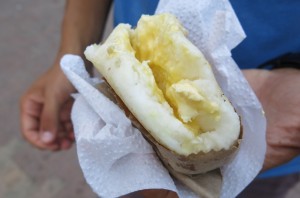
Unless queso is the local translation for “chunks of butter,” then this takes deceptive marketing to a new level.
You’ve been weighed, measured and magnified, Cartagena, and we find you quite brilliant. Who needs cut, color, clarity and carat?
Now, where’d I put my cuba libre?
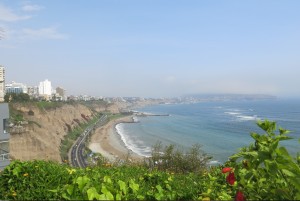 We didn’t plan on Lima. Sitting in Mendoza a week before, with only 5 weeks left on the itinerary, all we knew is we wanted to spend the majority of our remaining time in Colombia. So after about 7 hours of Dave doing his best Chloe O’Brian (…we really need to make more 24 references), we determined there was no affordable option to get ourselves to Colombia from Mendoza that didn’t involve risking dangerous border crossings in Ecuador and/or 64 hours of bus transfers through Chile and Peru. So, after some more high-level hacking, we netted out with the decision to bus over to Buenos Aires (which you can read about here) and then to hop a cheap(ish) flight to Lima, onto Colombia (takes deep breath). This is how we ended up spending 4 days in the improbable coastal desert.
We didn’t plan on Lima. Sitting in Mendoza a week before, with only 5 weeks left on the itinerary, all we knew is we wanted to spend the majority of our remaining time in Colombia. So after about 7 hours of Dave doing his best Chloe O’Brian (…we really need to make more 24 references), we determined there was no affordable option to get ourselves to Colombia from Mendoza that didn’t involve risking dangerous border crossings in Ecuador and/or 64 hours of bus transfers through Chile and Peru. So, after some more high-level hacking, we netted out with the decision to bus over to Buenos Aires (which you can read about here) and then to hop a cheap(ish) flight to Lima, onto Colombia (takes deep breath). This is how we ended up spending 4 days in the improbable coastal desert.
The tipping point may have been the “You have to go to Lima…the food is SO GOOD,” uttered from the phenomenally talented Chef Mun when we dined at his restaurant in Mendoza.
Who are we to doubt a great palate??
So go and eat we did.
With incredibly tender pollo a la brasa from Don Belisario and enough ceviche to feed a blue whale (our favorites being the tangy ceviche at La Canta Rana in Barranco and taste-bud tingling mixto at La Red in Miraflores), we thought it couldn’t get any better. Then we heard about Chez Wong.
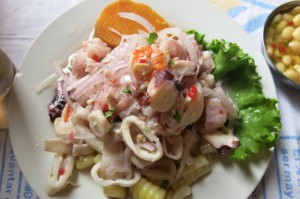
Ceviche at La Canta Rana. The Peruvian version of this dish is traditionally served with a chunk of sweet potato. Odd at first, it completely grows on you.
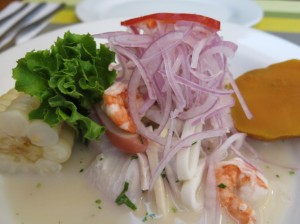
La Red ceviche. Onion heavy and delicious. (Note repeat performance by the charismatic sweet potato.)
One of the more unique dining experiences I’ve ever had, we arrived at an unmarked door precisely ten minutes before 1 pm, as instructed. Ushered into a small, 10-table room in a squat house on a residential street, we immediately loved it. The Chef was exactly as we’d pictured (someone somewhere referred to him as an Asian Samuel L. Jackson, and we reeled at the accuracy), and the ceviche was as fresh as promised. Usually marinated in lime and various juices for hours, the fish in the famed Peruvian ceviche is always dripping with flavor that puckers your pout. That’s why, when we watched Chef Wong filet a grouper in front of our eyes, cut up some octopus and onions and dunk it in the lime-based marinade and serve it minutes (EDITOR’S NOTE: Nay, seconds!) later, we were hesitant. But it. Was. Heaven.
As for the “hot plate” dishes that followed (there is no menu, you eat what the Rock Chef is cookin’), I must say, did not live up to the same hype as the ceviche, but we were still distracted enough not to care. But as there was no menu, I can not totally account for what was in the dish. I recognized fish, cantaloupe and mushroom but the wrinkly black somethings were beyond my culinary range or recognition.
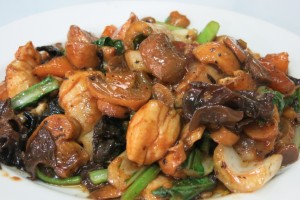
What’s this you ask? My translation skills may be rusty, but pretty sure it was something like, “Doan’ WORRY ‘bout it.”
Before our visit, we’d tried diligently to find out the price of such a mysterious meal, but it seemed Chez Wong’s meal cost has the same #1 rule as Fight Club. You don’t talk about Fight Club Chez Wong.
As to not anger our main alpha male, Brad Pitt, we’ll keep to the rules. Who am I kidding? Screw that guy (this is for you, Jennifer Aniston!). Our bill jaw-droppingly (to us) came to $100 – with, mind you, no drinks. Notsomuch in a backpacker’s lunch budget. Good thing we had that stock of granola bars.
To burn off all the savored calories, we spent full days exploring the various neighborhoods and walking along the coast. The filmy haze was annoying, but you still got pretty great Pacific views for hours of hoofing it along the coastal pedestrian paths (well done on those, Lima. Mendoza, take notes).
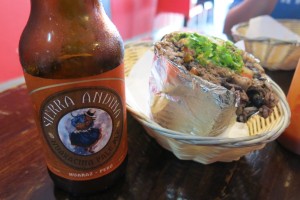
Excellent lunch at Burrito Bar in Barranco (if you can find Sierra Andina’s Pale Ale, try it…one of the few microbrewery options in Lima).
Another amazing perk of our unexpected side-trip to Lima was meeting up with Dave and Janelle, friends of my friend Paige and her husband from when they lived in Cartagena, Colombia a few years ago. Dave and Janelle now live in Lima with their two adorable kiddos, and we had the pleasure of spending an evening at their home early in our stay. Home-cooked Lomo Saltado (a national favorite stirfry dish of beef, potatoes and veggies), local Edam cheese (I’ll take whatever I can get) and several bottles of wine later (us, not the kids, COME ON!), we were fast friends.
So much so that they made more time in their busy schedule for us the evening before we left. We shared stories over a couple Cusqueñas in Larcomar (a beautiful outdoor shopping mall literally built into the side of a cliff overhanging the Pacific Ocean) before they taught us the ways of Peruvian bar food. Armed with Chilacanos (pisco-based drink which is basically like a less-sweet margarita and comes in lots of funky flavors like purple rice, etc), we snacked on causa (looks like lasagna, tastes like potato salad), pork and lomo taquitos and fried aji de gallina (hot peppers, chicken, and a cream sauce) croquettes.
We can only hope they visit Chicago someday so we can return the favor with a tour de Deep Dish and Wiener Circle.
So if you can look past the pollution and the lingering doubt of personal safety, I highly recommend including Lima in any Peruvian vacation itinerary.
Thank you, travel gods (and Aerolineas Argentina). You made this one easy.
It was a month packed with new adventures, from some of our favorite stops in New Zealand to our whirlwind start in South America. It was nearly impossible to pick our favorites this month, but alas, the show must go on. Check out our top moments from March:
10. I’ll call this our “day of views.” We fell asleep near Lake Tekapo under a “dark sky reserve,” which basically means the stars are un-freaking-believably vibrant and visible. We took our morning coffee at the top of Mt. John Observatory overlooking the southern alps and then later enjoyed an afternoon beer at Hilltop Tavern before making our way down into Akaroa. I don’t think another day on this trip will rival the visual memories made that day in New Zealand.
9. Although I complained through the first 15 minutes (insisting the hike was presented as a “pleasant stroll” by my dear husband), the strenuous Queenstown Hill hike was a can’t-miss. The views from the top overlooking New Zealand’s adventure capital were a sight to behold. From the snow-streaked mountains to the crystal clear lake waters, I was in awe.
8. Our evening spent “learning tango” in Buenos Aires (and more importantly, watching others who can actually tango) was so, so fun! The sexy vibe and incredible music made for a night full of flavor.
7. Delicious red meat. Everywhere. And yes, I gave Argentinean steak it’s own spot. Because IT IS SO AMAZING.
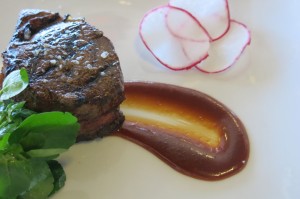
MUN’s Korean-style ribeye in Mendoza.
6. The Valparaiso cooking class we took with Caitlin and Jeff was a highlight of the month not only due to the new culinary skills we obtained, but for the delicious end product: empanadas, ceviche, corn pie and drunken pear dessert…all made by yours trulys. We left vowing to cook Chilean food asap when we got home.
5. Our 36-hour layover in San Francisco during our cross-continent flights resulted in a major March highlight – time with my dad! We had an incredible seafood dinner on the water, strolled to Ghirardelli for dessert and spent the evening catching up. Being away from my family for so long has not been easy for me, so his hugs reenergized me for the last part of our adventure.
4. The majestic Milford Sound – a MUST on any New Zealand visit. The sheer beauty of being on the fjord made it a morning I won’t soon forget.
3. My first Caitlin sighting was enough to raise my heart rate to an unhealthy level. Then, that evening, we dined on cheese, meats, baguettes and excellent wine in the backyard of our B&B and got the best gift of all…they asked Dave to officiate their wedding! I can’t wait to be standing beside Caitlin and watching my love marry two of my favorite people!
2. We spent our last day in Mendoza riding through the Andes abreast our new friends, Maria and Gus. Our scenic horseback ride and delicious asado (BBQ) gave us the taste of Mendoza we were happy to end on.
1. I know this is a cop out, but the visit from Caitlin & Jeff held too many highlights to count separately. From our day of wine tasting to our lunch at Caserena to our empanada and beer breakfast on our balcony in Valparaiso, their visit was a “vacation” we’ll never forget…and plan to recreate as often as possible in the future!
10. Our unexpected audible to Uruguay. Far from the most exciting or stunning place we’ve visited, Colonia was a charming little town perfect for a quick visit before we headed north. These sorts of unexpected decisions and developments are one of the things I’ll miss most once this trip meets its end in May.
9. The underrated beer mecca that is New Zealand had one last hurrah in store for us. The wide range of beers on tap at Pomeroy in Christchurch had us in hop heaven, but the Three Boys Hop Baron (combined with the unreal view from Hilltop Tavern in Akaroa) may have been the best of all.
8. Our quick layover in San Francisco whet our appetite for our upcoming return to the States, and came with the added bonus of a special cameo from Papa O. Filled with amazing meals and some touring around the city, this provided the recharge we needed for the final leg of our trip.
7. Wine tasting around Mendoza. The biking proved to be more of an adventure than we would have hoped, but once the sweat (kinda) dried I couldn’t help but love the amazing sips around almost every corner of this world-famous wine region.
6. Mendoza meals with Jeff and Caitlin. Our lunch at Casarena began with a champagne welcome before we were treated to a tasting menu that includes sushi and steak (among other treats) all while gazing at vineyards that seemed to stretch off for ages until they quickly meet an end at the base of the awe-inspiring Andes, making for a memorable meal. And then there’s our dinner at Siete Cocinas, which still practically makes me drool just thinking about it. Unforgettably amazing food in an amazing place. I’d say we cleaned up nicely for the Immelways.
5. You can only go on about the views and scenery around New Zealand for so long – and we’ve done plenty of it – but we combined two of the best experiences into one day when we cruised around Milford Sound in the morning and trekked up atop Queenstown Hill in the afternoon. If one day can encapsulate the range of scenery in such close proximity around New Zealand, this was it.
4. The red meat diet we followed throughout Argentina. I mean, you’re not gonna not binge on red meat when you’re there. Whether it was the bife de chorizo in Buenos Aires, the previously mentioned cuts of meat after our horseback riding or the countless other steaks we tucked into around the country, we left feeling like we did it right. That, and like our arteries were begging for a break.
3. Horseback riding in the foothills of the Andes just outside Mendoza. Our one and only experience this year on horseback was a good one. After a couple hours’ ride, we were treated to what seemed like endless amounts of red meat and red wine and met some great people along the way.
2. Exploring Valparaiso by foot and by food. The combination of color, grit, ocean views and delicious food on offer around this port city makes it hard to not have a borderline obsessive level of interest. Empanadas, ceviches and even some good ol’ homemade guacamole courtesy of Señor Immel left us stuffed and satisfied in between the constant hill climbs and neighborhood strolls around the city. Add to that a full day’s cooking class with fresh ingredients from the local market, and you can see why we loved this place.
1. Everything about Jeff and Caitlin’s visit in general. As I’m sure is apparent from the multiple appearances they made on this list, we enjoyed our time throughout Chile and Argentina with these two. From the quick stop in Santiago (where, oh by the way, THEY ASKED ME TO OFFICIATE THEIR WEDDING!) and onward to the amazing food, wine and walking around Valparaiso and Mendoza, their nine days with us will always stand out as a highlight of the entire year, making this an easy choice for the best part of March.
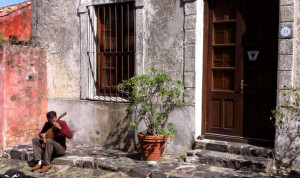 Talk about unexpected stops. At no point ever did we anticipate exploring this small South American country tucked between Brazil and Argentina on the continent’s Atlantic coast, but there we were. Due to a random flight search that revealed an unbeatable fare from Montevideo (the capital of Uruguay, but you already knew that…) to Lima, we worked in two days in Uruguay on the tail end of our Argentinian exploration.
Talk about unexpected stops. At no point ever did we anticipate exploring this small South American country tucked between Brazil and Argentina on the continent’s Atlantic coast, but there we were. Due to a random flight search that revealed an unbeatable fare from Montevideo (the capital of Uruguay, but you already knew that…) to Lima, we worked in two days in Uruguay on the tail end of our Argentinian exploration.
After a quick ferry from Buenos Aires, we settled in for 36 hours in the UNESCO World Heritage site city of Colonia del Sacramento, more commonly just called Colonia.
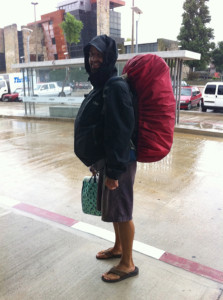
Colonia has a mild humid subtropical climate, which means it rains a lot. Exhibit A. (EDITOR’S NOTE: No, Dave has not preternaturally gained his well-earned gut two decades early. That’s just our small backpack containing all our electronics. Because ALWAYS SAVE THE BACKPACK.)
Colorful cobblestone streets and squares, old architecture, cafes and local food (namely Chivito, a heart attack waiting to happen on an overflowing plate) filled up our day and a half in this charmer before we hopped a bus to Montevideo for our flight out of the country.

Live music and delicious food at El Drugstore, a popular restaurant in town. Naturally, we had chivito.
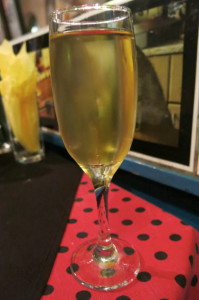
Along with the similarly overpriced signature Uruguayan drink, Medio y Medio, a sparkling wine comprised of moscato grapes and pinot blanc. A must, according to Noelle.
And now we can say we’ve been to Uruguay. So we’ve got that going for us. Which is nice.
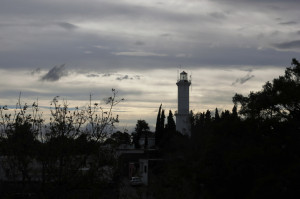
The Barrio Histórico was originally enclosed by a fortification wall, but most of it was removed in the late 1700’s. Colonia’s 19th-century lighthouse, one of the town’s most prominent landmarks, provides an excellent view of the old town.
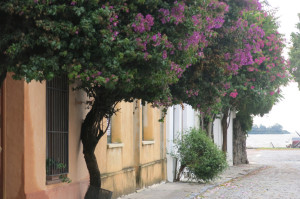
The rain let up our second day so we were able to fully appreciate the walkability of the town and the charm of the irregular terrain-accomodating street plan in the historic quarter.
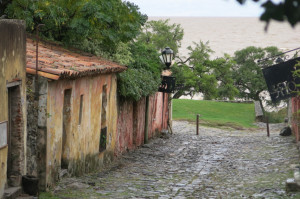
Colonia’s “Street of Sighs,” an 18th-century mossy-stoned passageway, lined with russet and gold ombre stucco buildings.
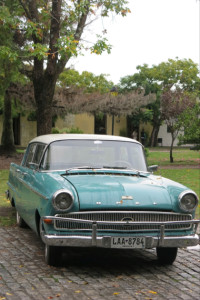
The town has an interesting fascination with vintage cars. You’ll find them “casually parked” (aka on display) on the cobblestone streets throughout the city.
Noelle made her first trip to Buenos Aires in 2010, while this was my maiden voyage to the Argentine capital. So we thought it’d be interesting to share the favorite parts about this bustling city from both perspectives. With that, I give you the He Said/She Said of Buenos Aires.
He Said: Palermo Soho came highly recommended and seems to be a popular spot for gringos. After spending four nights stationed here we can see why. Earning its name from the Soho neighborhood in Manhattan for the area’s resemblance to its American idol, the tree-lined streets are littered with inviting cafes and restaurants marked by sidewalk seating areas. Whether it was dinner and drinks with friends, exploring the weekend market at Plaza Serrano, seeking out the ever-present red meat offerings, searching for a tango lesson or just aimlessly wandering around the colorful and charming streets, we were happy with our decision to stay here.
She Said: I agree with Dave – Palermo Soho is where I’d suggest spending most your time, and it wasn’t a neighborhood I’d explored much during my last visit. However, my heart is pulled to the bohemian flavor of San Telmo – the oldest barrio in the city with quaint cobblestone streets lined with cafes, Tango parlors and antique shops. Head to Plaza Dorrego to stroll the market stalls and catch street Tango – grab a seat and a bottle of wine and enjoy the show!
He Said: Rey de Copas in Palermo Soho. Our first night in BA kicked off with meeting my friend Tim (who runs an amazing blog worth checking out if you’re coming here – A Gringo in Buenos Aires) and his wife Cynthia at this cocktail bar in our ‘hood. Translated, the name means “King of Cocktails,” and what it lacked in crowds (it was a Tuesday after all), it made up for in atmosphere and creative touches. For instance, our bill came with four crisp playing cards with, you guessed it, a king (presumably the king of many cocktails himself) on it. In addition to its hip atmosphere (is that what the kids say these days?), it was memorable for the fact that they had an amazing bloody mary, helping curb my withdrawal a little longer until we get home to Chicago where the bloodys flow like wine. Noelle went with a tall glass of…something with vodka. Definitely worth checking out for a fancy beverage before a night out on the town.
She Said: Anything in Palermo Soho. Plaza Serrano is the main party square with a ton of open-air bars ringing the plaza, but we preferred the streets a few blocks off for their cute, cozy cafes, perfect for relaxing with a bottle of wine. We visited Temple Bar with its funky Tomb Raider resemblance with Tim and his beautiful wife after dinner for a few pitchers of beers. With artisanal beers on tap, it’s a good pick for beer lovers. If wine is more your speed, we enjoyed a stop at a wine bar on Gorriti where we personally selected a bottle of wine from their cellar and enjoyed it at the refurbished wine barrel tables.

Can’t for the life of me remember or find the name of this wine bar, but if they offer to uncork the bottle of wine you selected from the attached shop for a small fee (that includes cheese and olives), you’ve found the place.
He Said: Plaza de Mayo. Many of the bigger cities we’ve been to this year seem to have been built out from a central square or plaza, and Buenos Aires is no exception with Plaza de Mayo providing the heartbeat for this lively metropolis. A great spot for people watching or just taking in the historic buildings on its outer edges, Plaza de Mayo is a good spot to start any sort of urban exploration. The most notable building here is easily Casa Rosada, the building from which Madonna Evita pleaded for Argentinians to hold back their tears, but not keep their distance (don’t act like you don’t know what I’m talking about). It currently serves as the Argentine equivalent of the White House. After becoming so accustomed to the extreme security measures for such buildings in the U.S., it was equally disconcerting and refreshing to see how up close and personal to the PM’s office everyone can get every day.
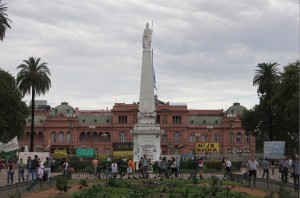
Looking across the plaza toward Casa Rosada, hidden behind the Pirámide de Mayo and plenty of protesters’ banners and signs.
She Said: La Recoleta Cemetery was a haunting visual I couldn’t shake after my 2010 visit, and I was happy when it was just as eerily beautiful as I remembered. After a false start (note: don’t arrive at the gates at 5:30 pm…it closes at 6, but they stop taking visitors a half hour before. Tragic.), we took a morning stroll through the rows of mausoleums, the bones inside enclosed in an array of marble, glass, stone, brick and wood. Many graves stand in various stages of disrepair, while some maintain their immaculate air, even some 100 years later. It’s really a sight to see.
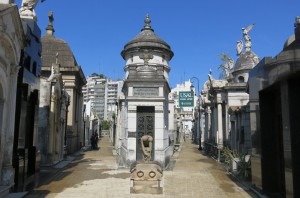
In 1732, the gardens around an existing church and convent became La Recoleta, the first public cemetery in Buenos Aires.

The entire cemetery is laid out like city blocks, with wide tree-lined main walkways branching into sidewalks filled with mausoleums.
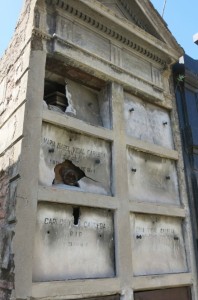
Building materials for the original tombs were imported from Paris and Milan. This one is a bit worse for the wear.
He Said: La Boca. The colorful neighborhood provided some great photo opportunities, but it had tourist trap written all over it. Street performers, retail shops in all directions and thick crowds give off a sort of amusement park feel. After about 15 minutes of walking around we were ready to jump back on a bus to the city center. It’s an easy place to guiltlessly skip if you’re crunched for time (or even if you aren’t).
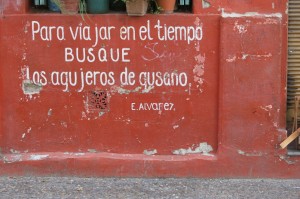
Roughly translated, this means “For time travel, look for wormholes.” If only I could find one to get me back to a better part of the city…
She Said: Bingo. The memory of my last visit consisted only of the vibrant colors, cold beers and staged Tango shows, but a second visit revealed La Boca to be a bit gaudy.
He Said: La Cabrera. One of the main “touristy” parrillas (BBQ grill restaurants that run rampant in BA) in Palermo Soho, La Cabrera not only had amazing food, but they offer a “happy hour” of sorts if you’re willing to grab your dinner between 6:30-8pm. What may seem like an abnormally early meal for Argentinians conveniently fell in, you know, the normal dinnertime window for most of the world, so we got the 40% happy hour discount on our bill. My giant ojo de bife was delicious, but Noelle’s bife de chorizo was otherworldly. The meat (appropriately marbled with fat, because Argentina) practically melts in your mouth. We also had our introduction to proveleta here. What’s that, you ask? Simple – fill a cast iron pot with a giant portion or provolone cheese, mix in some seasonings and throw it in the oven. The result is a mouthwateringly delicious melted cheese blob just waiting to put you into a joyful food coma. We left full – borderline painfully full – and I’ve found myself daydreaming about the meat and proveleta regularly ever since.
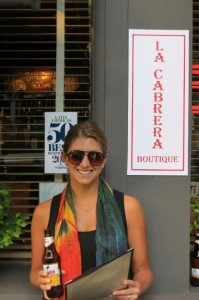
In case you do go here during a visit (and you should), get there before the doors open at 6:30pm as a line starts forming closer to 6pm. Also worth noting — the bar across the street sells takeaway beers to help you pass the time.
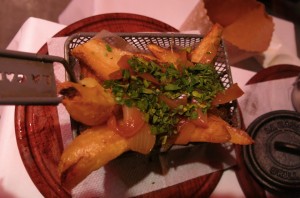
Some fries on the side. Because, you know, the gargantuan steaks and accompanying proveleta cheese blob just weren’t enough.
She Said: Don Julio, the much recommended and much deservedly raved about parrilla, earned the gold star in my book. The old school atmosphere was charming, the wine was superb and the service was friendly. But more importantly, the bife de chorizo was excellent. Cooked to perfection and served with the perfect steak knife, we were seamlessly sawing through our portions with gusto. The only black mark on the experience was the lackluster proveleta, but the chorizo we ordered alongside it more than made up for it. Topping the meal off with a mouth-watering dulce de leche pancake, Dave had to roll me home.
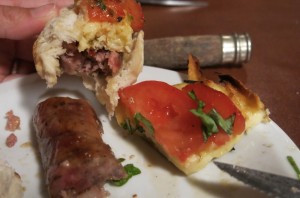
We got creative with the chorizo, using the tomato from the proveleta and table bread to make mini sausage sandwiches.
He Said: Fourteen hours on an overnight bus and a 45-minute sweat fest of a commute across the city from the bus station found us still about 15 minutes from our airbnb apartment. We were tired, sweaty, hungry and moving through this crowded metropolis like backpack-wearing zombies. And then we saw a pizza in the window and time stood still…for about 10 seconds before we both agreed “I could eat if you could.” And that was that. Kentucky’s simple, succulent and perfectly-timed provolone pizza was just what the doctor ordered. Fresh from the oven in a cast-iron pan, it was a proper introduction to the surprisingly vast Italian offerings around Buenos Aires.
She Said: A favorite among taxi drivers, Güerrin has been a Buenos Aires institution since it opened in 1932. Enjoying a slice of Fugazza (thick-doughed pizza topped with a profusion of parmesan cheese and onion) standing at the front bar with a crowd of locals was an experience drenched in tasty tradition.
He Said: Tacos at La Fabrica del Taco. I love me some Mexican food and we’ve been limited in that department for a while. La Fabrica’s al pastor and al asado tacos (along with some amazing chips and guac) hit the spot for us. It didn’t hurt that we ate right at the taco bar on the sidewalk that faced into the kitchen. Great spot if you’re craving good Mexican food.
She Said: The empanadas in South America have been a favorite snack of ours, eaten any time of day. Güerrin (the same place that scored my favorite pie) took it a step above, offering deep-fried empanadas. Cholesterol be damned, it was delicious.
He Said: Café Tortoni. Touristy? Without a doubt. Still worth the stop? Absolutely. The miniature coffees served by old-man waiters were a bit overpriced, but I couldn’t resist after taking a look inside and being transported back to our days of café und kuchen in Vienna (and really, I just wanted another excuse to say and write the word “kuchen”).
She Said: Clasica y Moderna Libros. Exposed brick and delicious café made for an enjoyable escape from the rain. Plus, there’s a bookstore inside. Easy win.
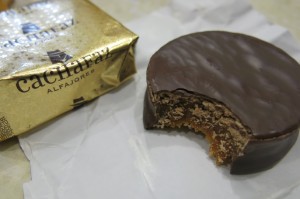
And while we’re on the subject of something sweet…we spotted people everywhere enjoying these dense, chocolate cookie (or alfajores) with their coffee. They’re on to something here…
He Said: Our second night brought us a surprise homemade empanada dinner with our lovely airbnb hosts, Damian and Laya. We’ve become fans of these sorts of meat and/or veggie filled treats ever since we had our first momos in Nepal. It continued in Chile and we were happy to keep the empanada train rolling in Argentina. Laya invited us to make a couple batches with her, and there was no chance we were saying no. Noelle carried much of the conversation from our end (per usual), which was good for me since I’m pretty sure I may have blacked out from deliciousness a few times after tucking into the homemade deliciousness.
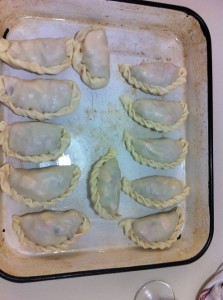
(EDITOR’S NOTE: Also per usual, Dave carried the Bauer cooking load. His may not have been the prettiest – see top left – but they tasted delicious all the same!)
She Said: Our short-lived tango lesson! We knew we wanted to catch a show while in the home of the famously sensual dance, but decided in the end to attend a mélange instead. While still technically a “show” (aka the less coordinated watch those who can actually tango), it’s really a dance hall where locals gather to dance each night. We impulsively decided to head to La Viruta on a recommendation from Tim and Cynthia the night before, to take advantage of the brief lesson they offer to beginners beforehand. Great idea, right? Well, take into account it’s in Spanish (which we do not speak) and that TANGO IS REALLY HARD (to an extent we didn’t expect), and you’ll see why it may have been a bit presumptuous. But we sure have the first catorce (that’s 14, of course) counts DOWN. Upon which Dave suggested we get a bottle of wine and watch the rest of the class from our seats. Sigh.
He Said: Medialunas for breakfast. Marked by nothing more than a simple tweak to the always-reliable breakfast croissant, I would not be opposed to welcoming these ever-so-slightly glazed treats to the U.S. We found some amazing ones around Buenos Aires after our introduction to this Argentine staple in Mendoza. Fresh-out-of-the-oven batches at an unassuming corner café and a small, neighborhood bakery in Palermo Soho showed us the way these are supposed to taste, and croissants have been less fulfilling ever since.
She Said: One of the more most rampant local customs is the consumption of maté, a tea made with leaves from the local yerba maté plant. Consumed from the traditional gourd cups or just your standard mug, the beverage is everywhere. People literally carry around thermoses filled with the stuff to sip as they walk down the street, enjoy lunch, work at their desks…wherever and whenever, really. As the ninth largest tea-producing country, it stands to reason it’s so common, but the devotion to the drink by the locals borders on religious.
Ah, Mendoza. Where the wine flows like…wine.
A land ripe for a holiday romance, and oh, dear readers, did we have one for the history books.
It started in Chile. We had fallen head over heels for our travel partners, Caitlin and Jeff, and we were ready to bring it to the next level as we hit the Mendoza border.
The stage was set with a romantic eight hour ride on the most comfortable bus we’d been on in 12 months (seriously, the accidental $3 upgrade the boys made in the catawampus Spanglish conversation they had with the bus company paid off in spades. We were sitting pretty in plush first class seats as we cruised through the Andes), but our sweaty palms betrayed our fear of rejection. Did they feel the same? Then, as we hit the border crossing and the Immelways held the bus while I was being questioned about the visa that no longer matched my last name, we finally exhaled (for more reasons than just feeling relieved I wasn’t thrown in a Chilean prison). We were finally sure the feeling was mutual.
Arriving to our palatial love nest near the Mendoza “suburb” of Chacras de Coria (located in the popular Luján de Cuyo wine region), we settled in for a few days of nothing but blue skies and good company.
Turns out we’d have to settle for the good company.
This year’s rainfall and cold temps has sent viticulturists into a tizzy with fears that they’d miss the harvest window. No joke, the region saw more rain in a handful of March days than they usually see all year (the dry climate is one of the reasons the region is usually so ripe for wine growing). However, with four A-type personalities, there was nothing to do but soldier on with our bicycling winery tour plans. Plus, what better way to solidify this budding romance than with a jaunty wine-tasting tour of the countryside?
Donning cute dresses (Dave and Jeff, of course) and hopping on our seemingly trusty 2-wheeled steeds for the day, we set off for a day of wine tasting in this mountainous region of Argentina.
Spoiler Alert: It would only end in tears (again, Jeff and Dave).
Not only was it about 50 degrees (rendering the dresses absolutely ridiculous after 5 minutes), but most of our ride was on uneven gravel roads with no bike paths to be found, meaning we weaved precariously between traffic as we navigated the miles between vineyards. A flat tire and missing bike pedal later, we were ready to give up on Mendoza wine tasting. SERIOUSLY. YOU’RE TOTALLY RUINING OUR DATE!
To be fair, the three wineries we visited were really wonderful. The first, Vistalba, was a picturesque vineyard that literally made you stop and say, “We should get married here.” (Which we did propose…to the Immelways. They were oddly tentative.) (EDITOR’S NOTE: Let the record show that the first wine tasting was at 9:30. In the morning. Because wine apparently takes priority over time of day in these parts. So when in Rome…) With a dimly lit cellar and atmospheric tasting room (complete with a glass wall giving a peak at the rocky soil that somehow makes Mendoza wines so ridiculously delicious), this place was exactly what you wanted an Argentinean vineyard to look like.
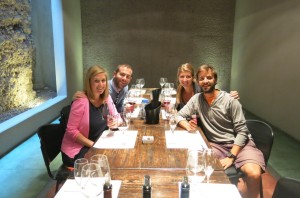
Our cosy tasting room under the vines. (The tasting was accompanied by chocolate. Breakfast of champions.)
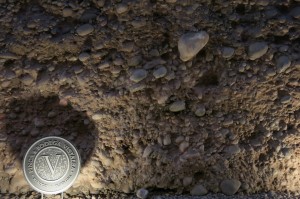
A glimpse of the rocky soil through a glass wall in the tasting room. How anything grows here is amazing.
After a quick change to jeans and long sleeves (SO not what I pictured for my South American wine-tasting ensemble), we made our way to Pulmary, the family-owned, organic vineyard that churns out a mere 40k bottles each year (in context, the vineyard we would visit next bottles 2 million per year).
But before that, we obviously (as the day’s events had been trending) got lost. Shockingly, the hand drawn map by our Mendoza host (who lived in the house next door) was NOT as clear as we had insisted it was. A moment of clarity: our host hand drew the map because maps of the area don’t exist. WHAT SORT OF WINE TASTING REGION DOESN’T HAVE WINERY MAPS?
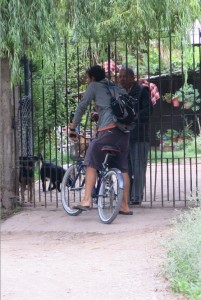
Dave asking directions from the man with 8 loudly barking dogs who only spoke Spanish. You can imagine how that conversation went. (EDITOR’S NOTE: To be clear, the dogs and their owner spoke Spanish. And for the record, “woof” in Spanish is simply “woofé.”)
Our many detours paid off in spades as we rolled into Pulmary (after a personal, near-death experience with an SUV), and took a tour of the humble winery led by one of the owners, Ramiro. Tasting wine from a cask, a wine thief (a long metal syringe that pulls wine from barrels – brilliant name) and unlabeled bottle, we were sold. Add to that an incredible grilled meal in the winery’s gardens with a bottle of their Torrontés (a white wine grape grown only in Argentina and Chile and frequently called Liar’s Wine because you expect it to be sweet, but upon taste, it’s dry) and we were back in our happy place.
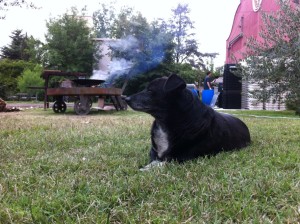
Poncho is not impressed. Although he was VERY impressed with the bite of Dave’s steak he refused to take no for an answer for.
A final stop at Alta Vista Vineyard capped off the day with a “mass production” experience (robotic tour, industrial feel, but EXCELLENT tasting), and we were on our way home. Our 1 ½-hour, sweaty, unpaved way home.
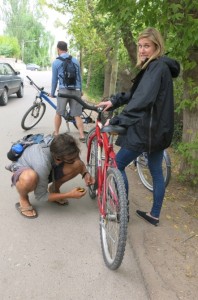
You know, just trying to get the pedal back on the bike. (From these photos, it seems Dave was trying to woo them with his engineerial skills.)
Not to be deterred from our seduction tactics (and really, it was an amazing day, despite the continued comedy of errors), the next day, we hobbled into town (seriously, you spend a day on a bike, and we’ll talk) we headed into downtown Mendoza to see what exactly “downtown” had to offer. A stroll through town showcased lovely greenspaces, beautiful tree-lined streets and – of course – delicious culinary offerings.
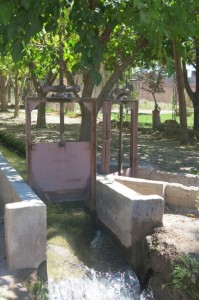
An irrigation system devised in the 1500s brought water from the mountains, allowing more people to live in the city. The system is still used today. (These wide trenches, or acquias, run along all city streets, watering the approximately 100,000 trees.)
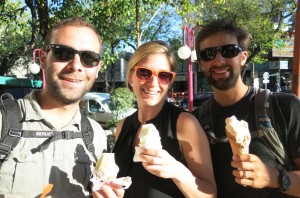
Local ice cream is amazing. Our stop at Famiglia Perin gave us the sugar rush needed to keep us to the next meal.
First up on our continued commitment to eating our way through the city was Anna Bistro, where we lazed in their vine-draped courtyard for a delicious meal of ojo de bife (ribeye), stuffed ravioli and lasagna (luckily, we’re all sharers). Burning the calories with a quick stroll through the massive city park, we quickly returned to our wonton ways in the form of a couple penguin-shaped carafes of wine at Palenque.
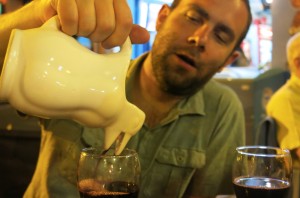
We found it very amusing that the wine pours from the penguin’s mouth. It’s the small things, you know?
This was followed by what can only be described as knock-down, drag-out A+ meal meal at Siete Cocinas. No really. If you’re in the area, make like Nike and just do it. The meal started with succulent sweetbreads clay oven cooked on molasses and purple pizza made with Api dough, arugula, cheese and pistachios, both of which were immediately shamed by the veal tail tortellini, rabbit confit in leek soup, clay oven roasted Patagonian lamb and roasted goat main courses. The chef made a regular hangout of our table, and we left with drool-crusted chins wishing we could take Mendoza home with us when we went.
And to really test the boundaries of consumption, the next day we visited MUN restaurant at Casarena Winery. Located on the sprawling, 249-acre vineyard with stunning views of the snow-streaked Andes, we would have been pleased enough with spending time on the patio alone. But when a glass of champagne was put in my hand as I crossed the entry threshold, I was happy to oblige the move inside.
The 5-course tasting menu paired with local wines brought palate surprises dish after dish. Not only did we gaze out on the Andes as we supped on fresh sushi, perfectly prepared filet and crisp, flavor-fueled greens, but we did so as we sipped on the best wine in the land. This holiday romance was shaping up to be one for the long haul.
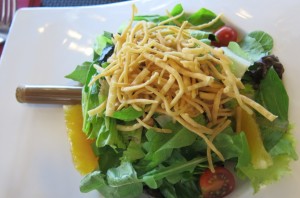
Crispy greens, cherry tomatoes, mandarin orange, cashews, wontons and served with a vial of orange honey-mustard dressing. Yes a vial. It was awesome.

Chilean Salmon nigiri & Yellowfin Tuna on crispy rice. Paired with Resreva Pinot Noir 2011, this was hands down my favorite course.
We spent that final evening in the most picturesque country hotel in the area – a surprise treat from Caitlin and Jeff that we lapped up like a kitten and its mother’s milk a fine Argentinean Torrontés (that felt more appropriate here). We have some pretty great friends. A last supper spent in the quiet kitchens of our scenic abode and hours chatting and laughing over more good food and great wine, we felt pretty damn lucky. We had met…The Ones.
And then just like that, it was over.
You can imagine the scene. Anger and betrayal bled to desperation and begging for a second chance. Heartbreak set in when we realized the split was for keepsies.
We waved goodbye to our dear friends as they boarded a bus heading back to Santiago to catch a flight. Drying our tears we realized we were, once again, alone. Our holiday romance had ended.
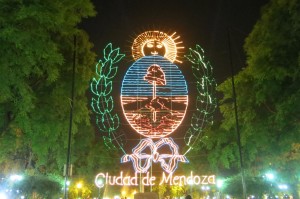 Left in pieces, Dave and I spent another 4 nights in the little town we’d learned to love, giving us time to nurse our broken hearts. We were listless, with no clue of our next move. We had spent our time in New Zealand, well, enjoying New Zealand or planning the visit with Caitlin and Jeff, and in any free time, drawing hearts around “Immelways + Bauers 4Eva.” Now we were left stranded in Mendoza with 5 weeks left before we had to return home ourselves.
Left in pieces, Dave and I spent another 4 nights in the little town we’d learned to love, giving us time to nurse our broken hearts. We were listless, with no clue of our next move. We had spent our time in New Zealand, well, enjoying New Zealand or planning the visit with Caitlin and Jeff, and in any free time, drawing hearts around “Immelways + Bauers 4Eva.” Now we were left stranded in Mendoza with 5 weeks left before we had to return home ourselves.
It was time to reevaluate our future without them. Head north to Salta for more wine tasting and national parks? Head south to Patagonia to brave the cold as we hiked peaks as Dave longed to?
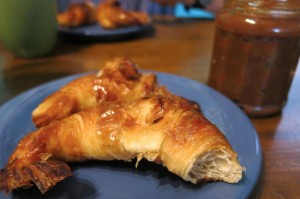
We spent our first breakfast eating our feelings. Medialunas (basically glazed croissants) and dulce de leche (basically caramel sauce) seemed to do the trick.
Well, we’d have 5 days for that sort of contemplation, and between long hours spent online and nose deep in our SA Lonely Planet book, we managed to enjoy Mendoza to its fullest capacity. Already satiated on red meat and wine tasting, we spent the next few days…well…eating red meat and wine tasting. (IT’S MENDOZA PEOPLE, WHAT’D YOU EXPECT?)
After our last experience with wine tasting in this yet-to-be-finessed rocky region, we were tentative (and yet, oddly determined) to venture out into the second wine “suburb” of Mendoza – Maipu. 5 hours, 2 bicycles, many potholes, countless angry, honking cars, one closed restaurant AND ONLY 2 VINEYARDS later, we had to accede that perhaps Mendoza could benefit by spending a little more time on its wine tourism industry that is currently focused on exportation (not that we don’t TOTALLY appreciate those efforts while in America, shopping the rows and rows of Mendoza wines at Binny’s). But just a little more road maintenance and consistency in hours could do wonders for this grape-rich mecca.
The two vineyards we did get to were really lovely. Carinae had a peaceful garden where we enjoyed one of their incredible Octans wine after the tasting (sold only from the vineyard) and an impromptu basic, but tasty chorizo and cheese plate (see above: closed restaurant). This respite was necessary as it took nearly an hour and a half to pedal to the vineyard from our bike rental pick-up spot. Sigh.
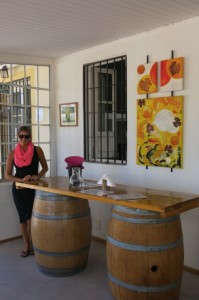
Cozy Carinae Winery. They name all their wines after constellations, scoring big with us loyal star-gazing fans.
And with just enough time to enjoy the last tasting of the day at one of the oldest vineyards in Mendoza, Familia Di Tomasso, we gladly sipped their delicious Malbecs and Cab Savs and admired their nearly century-old brick fermentation tanks. More importantly, we proved to ourselves that we could find happiness outside the confines of the Immelway vortex.
So the visit was absolutely not all for naught, but we were ready to throw in the towel. The rest of the wines during our stay would be purchased from the local liquor store.
But as they say – all can be cured with a bloody slab of red meat. You know them. They’re always saying that.
And while some would say that missing our beloveds had made food lose its flavor, we’re more in the camp of “eat to make you forget.” So not wasting any time, we booked a tasty meal at Azafran, consisting of ceviche, orange-infused risotto (amazing) and a perfectly-cooked pork dish. However, the real star of the place was the wine room. Before you order your meal, you’re invited to peruse their wine room to select the bottle of wine for your meal (assisted, of course, by the on-hand sommelier). Nice move Azafran.
And just when we though our foodie adventures couldn’t get any tastier, we went to the Mendoza institution, 1884. Chef Frances Mallman’s signature restaurant is in an old winery (established in – yep – 1884) and accessed only through an unmarked door, giving the whole experience a very mysterious and romantic air. Known for his fire-based cooking, a quick walk in the gardens reveal traditional Argentine barbecues and the chefs at work. It was here we had arguably the best steak in Argentina. After our innocuous arrival, we dined on marinated prawns, prepared-to-perfection ojo de bife and the succulent seven-hour grilled lamb. Had we found our new perfect match??
Perhaps not, but we were back in the saddle. Literally. We made the decision to spend our last day a little closer to the mountains we’d ogled at from a distance for so long. We rode horses through the Andes. And yes, it was as awesome as it sounds.
Picked up by Nacho, our very own gaucho (the equivalent of our “cowboys” but way more badass), we and a minivan full of other lasso-dreaming outlaws headed to the foot of the Andes for an afternoon of hoofed adventure and asado (like our BBQs, but again, more badass). Poor Dave was partnered with feisty Maria who seemed determined to make him work for his dinner, while I was seated on obedient – although sassy enough to earn my affection – Gus.

A mild equine flirtation was explored, but my guy was soon over Maria’s “look at me” tactics of bucking Dave, refusing to move and sprinting across the dusty flat stretches.
An added bonus to the already awesome evening was our unexpected post-Immelway rebound – Dee and Zarius, a funny Irish girl (again with enough sass to make me love her), and a South African Matthew Fox (true story). We built a solid foundation on red table wine and grilled meat, and developed it further over fireside dancing. You know, the usual.
After sharing a final lunch of a greasy lomo completo the next day (the perfect meal for the day after such activities), we bid goodbye to our new friends (this time on our terms). Realizing we were finally ready to open our hearts again to the unknown, we hopped a bus to a place not even previously on our radar.
Buenos Aires.
¡Estamos en America del Sur! ¡Finalmente! That’s Spanish… for “We are in South America! Finally!”
It’s been a long time comin’, and in addition to the thrill of being able to practice more of that brilliant Spanish I just showed you, this leg of the trip started off with a little extra incentive. Two of our friends from home, Caitlin and Jeff, would join us to begin our tour of the continent with stops in Chile and Argentina.
We often referred to this as the vacation portion of our trip. “That is hogwash. You guys are on a year-long vacation,” you may say. But that’s not exactly accurate. Yes, we are traveling for a year and traveling on a non-work-related trip usually equates to vacation. But not always. Follow me…
When you are on a vacation, do you ever wake up in the morning not knowing where you’re sleeping that night? Do you get downright giddy at the thought of access to a hot water shower? Do you pray that your toilets are more than just holes in the ground? And do you typically have an income that’s replenishing your bank account as you travel? My guess is you answered “yes” to most or all of those questions. In our case, the answer is often “no” to many if not all of those. Don’t get us wrong – we are not looking for sympathy here. We’re aware of how fortunate we are to be taking a trip like this and seeing all the places we’re seeing. But my point is that we were finally on the cusp of what we had budgeted as a “treat. yo. self.” portion of the trip.
Enter Jeff and Caitlin (until they make things official with the same last name this November, we’ll smash up their last names and refer to them with their preferred current moniker: the Immelways). The Immelways had been planning on visiting us ever since we set off on this journey, and after landing on South America as our rendezvous destination the anticipation was palpable. (EDITOR’S NOTE: He may or may not be referring to my “happy dance” routine that frequented the days before Caitlin’s long – and not always patiently – awaited arrival.)
Our first couple stops on this glorious vacation were in Chile. For those of you who may not think of yourselves as geography buffs or map whizzes (I’m looking at you, Noelle) (EDITOR’S NOTE: It’s not supposition. It’s a fact, babe. I get lost in Lincoln Park.), think of Chile as the strip of fat on the side of the ribeye that is Argentina. It provides some flavor, but it’s often just disregarded in favor of the meaty part.
We begin in Santiago, the capital city of this strip of fat coastal country that serves as home to more than a quarter of the Chilean population. What can I say about this city that can’t be summed up with a yawn? Friendly people, clean, easy to navigate and quick to feel familiar, Santiago’s charm lies in its underwhelming comfort. You can walk around the city and feel like you’ve just picked it out of a grab bag of big cities, but I don’t really mean that in a bad way. That might sound harsh, but a must-see destination it definitely is not.
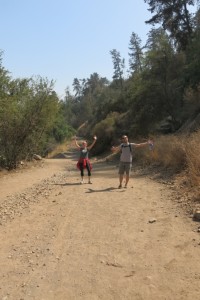
Exploring the hills of Santiago. We may or may not have underprepared for this unexpectedly steep hike.
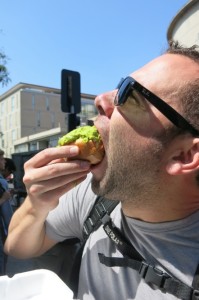
Post hike snack. Normal: Hot dogs are a popular street food. Not normal: The serving style is heaped with mountains of mayonnaise and guacamole (not that it deterred Jeff).
During our two days and nights in this unforgettably forgettable city we walked, we sweat (see: genetics), we enjoyed some sidewalk beverages and most importantly, caught up quickly with the Immelways, making our ten months away feel like no more than ten days in no time.
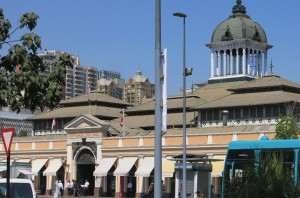
Mercado Central, Santiago’s fish market. Also a good place for a seriously fresh seafood lunch. Try Tio Willy’s.
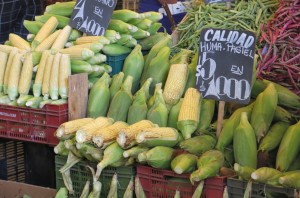
What we first thought was over fertilized corn proved to just be a popular variety of corn that produces large, chewy kernels, served with many local dishes.
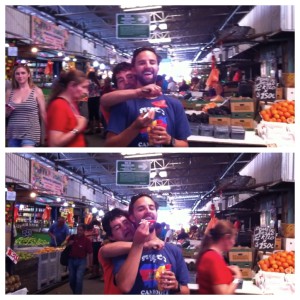
In retrospect, it seems odd that none of us were worried about the fruit vendor holding a knife to my neck. It’s all fun and games until someone gets shanked.
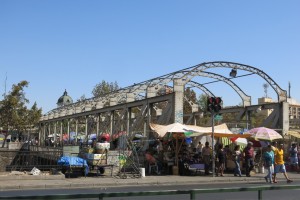
A pop-up market set up on a bridge sold everything from watches to shoes and veggies to radios. Caitlin accurately dubbed it, “Santiago CostCo.”
After the quick stopover, it was off to Valparaiso. This coastal city comes complete with street art, sea views and grit for days. Pablo Neruda, the famous poet who called this place home once wrote, “Valparaiso, how absurd you are… you haven’t combed your hair, you’ve never had time to get dressed, life has always surprised you.”
It’s a good description of the city that looks and sounds discombobulated and chaotic, but after spending time there you quickly realize that there’s an infectious method to the madness.
The city emulates a giant color palette, with building walls, sidewalks and pretty much any outer surface marked with street art and graffiti. Unlike many other places we’ve seen with frustratingly annoying graffiti (the always classy: “’[INSERT INITIALS] were here” signs on ancient statues), Valparaiso’s street art helps provide its identity.
Even the approach to the art is a universally accepted practice followed by everyone – artists will find a wall, sidewalk or other surface they’d like to paint, ask the nearby tenants if they’ll approve, and upon getting verbal permission they’ll get to work. It makes sense when you think about it – the last thing you’d want to happen to your hard work is for someone to whitewash it or cover it up somehow. We went a little nuts with the photos of all the art, but here’s a snapshot of some of the work around town:
Our home base for three nights in this eclectic city provided amazing views and a good, central location to explore from. Valparaiso has become a popular spot for tourists and Chileans alike – since Chile’s dictatorship rule ended in 1990, the population has steadily increased to 700k, nearly double the number that lived there 24 years ago. The city itself is set on a wide hill and for generations there were funiculars set up around the city to help climb the hills between neighborhoods. Many were in service as recently as five years ago until tragedy struck with a devastating 8.8 magnitude earthquake (the sixth largest earthquake on record since the turn of the 20th century) that rocked 80% of Chile, leaving over 500 casualties in its wake.
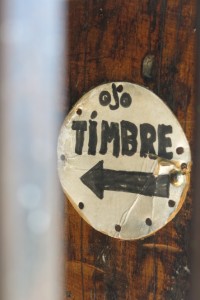
We secured the empanadas by employing a special signal at the barred wooden doors of a hole in the wall. You could say we’re empanada ninjas.
Luckily, this portion of the story finishes with a happy ending, where rebuilding has been underway and the busy port that Valparaiso’s economy revolves around is back in full service. However, the funiculars are the one major part of the city that has yet to be fixed. Hence our winding, sweaty hike up the massive, steep hill (luggage strapped to our backs) to our beautiful apartment upon arrival. We’ve become accustomed to these wonderful missteps that budget travel lends itself– aka our insistence against a taxi – the Immelways were not. We’re still sorry.
(Sidenote: Unfortunately, it seems as though the city can’t catch a break. After dodging another earthquake bullet weeks ago when a 8.2 magnitude earthquake struck off the northern coast of Chile, Valparaiso has been fighting off “perhaps the worst fire in the city’s history” in recent days.)
Our continued exploration led us through the vibrant city as we visited Pablo Neruda’s home and wandered the narrow streets of the colorful neighborhoods.
In between all the wanderings around town we did to take in the views and art around town, we found a few great restaurants for some memorable meals, but our best food may have come from our own efforts.
Following the lead of our trusty cook/leader/possible-MMA-fighter-on-the-side Vlad, we spent a day learning about Chilean cuisine and rolling up our sleeves for our attempt at making a few dishes ourselves. After a visit to the local market to pick up our vegetables, fruit, fish and other ingredients, we headed uphill to an unassuming kitchen on an unassuming side street to get to work.
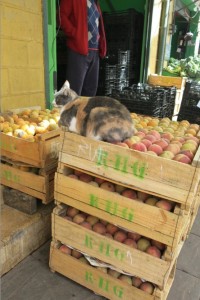
Yes, stray cat. We would love it if you would sit atop the fresh fruit we were going to buy. Muchas gracias.
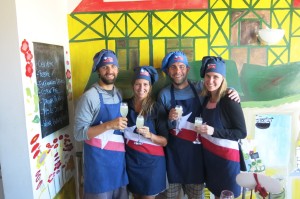
We came here to do two things: prepare some food and drink some pisco sours. And it looks like we’re all out of… oh, it looks like you put pisco sours in our hands. Cool, thanks.
Things got started with a quick wine tasting, where we were given samples of a few regional reds and whites, including Chile’s signature wine, Carmenere (Chile happens to be the only place in the world Carmenere grapes are able to grow, much to the chagrin of the French). Over the course of the next few hours we would slice, dice, mix, stir and watch a little bit of everything as we prepped a four-course meal complete with wine pairings and a pisco sour (because Chile).

Vlad either telling Caitlin how to pick apart a fish filet for ceviche or how to pick apart an opponent in the octagon. Anyone’s guess.
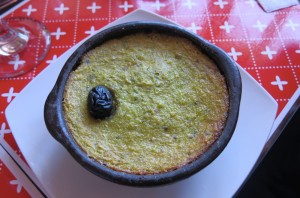
Third course — corn-based casserole. There’s corn in there, along with a heap of butter, sugar, salt, a little basil and one lonely olive.
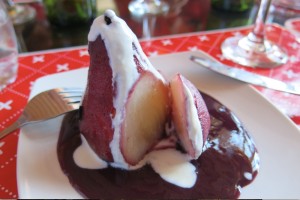
Dessert — a drunken pear. Peal the pear, cook it in a red wine sauce, drizzle it with some sort of dessert-like sauce… who knows, but it was amazing.
Three extremely late nights and many bottles of wine later, our time here was done sooner than we would have liked. Lucky for us, it was only the halfway point of the Immelway visit. Next up: Mendoza, Argentina to sample some more red wine and plenty of red meat.
Instead of heading straight to our final destination of Christchurch, we took advantage of the final days with our campervan road warrior. An hour’s detour east took us to to Akaroa, a stunning seaside village with French flavor on the Banks Peninsula. But, as with all things Kiwi, we enjoyed the journey just as much as the destination, taking advantage of the first sunny day we’d had in a while.
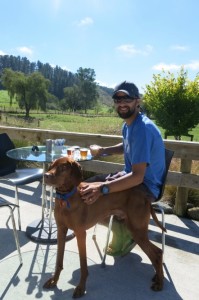
A quick stop to visit our friend Oscar at The Brewery Café and a taste of the Valley Brewing Co. beers brewed right there in the garage.
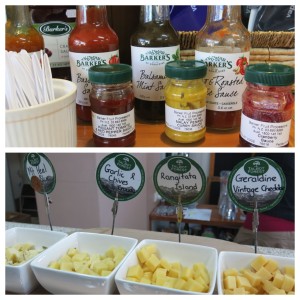
If you find yourself passing through Geraldine, be sure to visit Four Peaks Plaza to sample the daily selection at Talbot Forest Cheese or chutneys, juices and jams from Barker’s. Everything is crazy fresh. Oh! And swing by the Geraldine Fish Supply for some tasty fish & chips too.
Appropriately fed and back on the road, the jaw-dropping vistas as we neared the peninsula stopped us in our tracks. Like literally. We stopped at Hilltop Tavern to enjoy the picture-perfect views before our descent. Then, as we leisurely made our way past the smaller bays that indented the coastline (including Barry’s Bay where we stopped for some incredibly tasty local cheese), nous sommes tombés amoureux (EDITOR’S NOTE: Don’t bother Googling that. Knowing Noelle, I’m pretty sure it just means something about cheese or red wine… or both.).
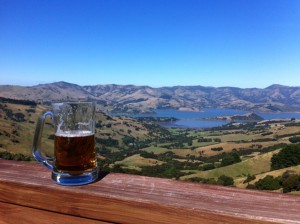
Three Boy’s Hop Baron Beer is just taking it all in. (Yes, I realize this is basically the same picture three times, but did I mention the view??)
The Banks Peninsula was formed following two violent volcanic eruptions. The resulting craters formed the harbors of Akaroa and surrounding towns, giving it that absurdly photogenic coastline. The surprising Francophile influence actually dates back to 1840 when a captain of the French whaling ship Cachalot negotiated with a local Maori chief to buy the peninsula. He swiftly returned to France and organized emigrants to return and settle in Akaroa. But he was too late. The Treaty of Waitangi (which named the entirety of New Zealand an English colony) had been signed days before his return. Charmingly, the French provincial town flavor remains to this day.

I found myself consistently fighting the urge to sing…”there goes the baker with his tray like always…the same old bread and milk to SELL!”(Disney DID in fact, exist before Frozen.)
So after a hearty late breakfast at the campsite, we were ready to hit the road. This time, taking Summit Road high along the ridgeline for a scenic drive back toward Christchurch, we continued to catch views that reminded us we were far from home.
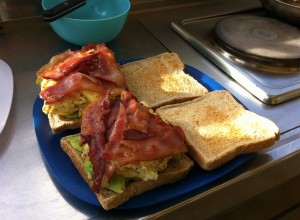
Oh. And that breakfast I mentioned. Because I can’t seem to resist taking pictures of the food Dave makes.
But we needn’t have worried. Radio ads kept a reality check in place as well. More than once, I gave pause, hearing a promotion for Pizza Hut’s “Marmite Stuffed Crust Pizza,” here or a PSA for Girl Scout “biscuits” there.
But oh how I had missed the radio. Over our three weeks on the road, we quickly caught up on all the latest American hits we’d missed while away. We learned to love John Legend’s “All of Me” (because it was in an every-other-song rotation. On every station.), always turned up the volume when Pharell’s “Happy” came on and spent hours trying to figure out who sang the bafflingly-popular hit “Fire, Fire, Fire.” (It was Bastille.) Apparently the only New Zealand artists getting airtime are Lorde and Kimbra (featured on the song you couldn’t escape or get out of your head for a large part of 2012, Gotye’s “Somebody That I Used to Know.”).
Volume cranked, off we went.
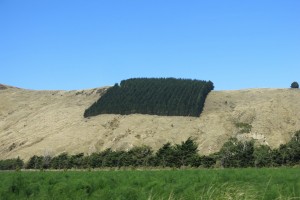
In other news, I’m currently working on a theory that New Zealand’s too-perfect setting isn’t natural at all. You say DOC, I say extra-terrestrial. Stay tuned.
Finally arriving in Christchurch, we said a teary goodbye to our well-worn home on wheels (EDITOR’S NOTE: Final tally: 23 days, 2900+ miles driven, or to put it another way, further than a drive from NYC to LA, approximately 57k sheep spotted, two car batteries and countless unforgettable views, meals and drives. We won’t forget you, White Lightning.), and quickly got to our exploration of the country’s second largest city.
And immediately felt the weight of the tragedy that struck three short years ago.
In September of 2010, a 7.1 magnitude earthquake struck in the middle of the night. Despite no fatalities, it caused widespread damage to the central city, buckled rail lines and in more rural areas, tore gashes in the countryside. But this quake was just a sign of things to come.
Six months later, in February 2011, Christchurch was devastated by a 6.3 magnitude quake (although lower in magnitude, the epicenter was much closer and deeper) that ultimately decimated the city and surrounding area. Happening just past lunchtime, the number of people out and about was massive, and over 185 people died. The city, destroyed.
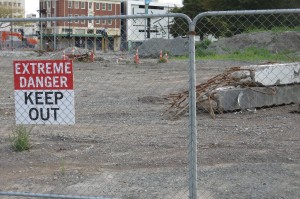
When tragedy struck, rural neighbors formed the “Farmy Army,” descending on the city armed with shovels and food.
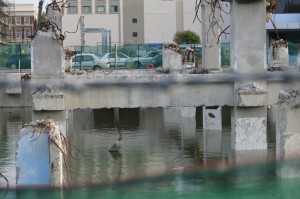
Adding insult to injury, the area has recently suffered intense rainfall, causing flood damage across the city.
And while I’d love to say that at least the physical elements have healed completely, instead I can tell you that the people of Christchurch are making the best of a terrible situation. Streets everywhere remain closed and construction barriers surround stretches of blocks in the Central Business District (CBD), or main part of town. The once-bustling city center seemed abandoned, and as we strolled the streets in the middle of the day and passed closed storefront after newspapered storefront (and only a handful of people), we grew morose.
Cathedral Square was perhaps the most heartbreaking. At the center of the square is Christchurch Cathedral, an icon of the city originally built in 1881. The earthquake decimated the historic building, bringing down the Gothic church’s 63m-high spire and destroying the beautiful stained-glass rose window. The Cathedral was deconsecrated in October 2011, and plans to demolish the lot are in place (not a popular position among locals).
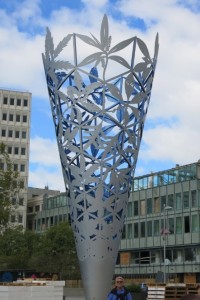
One of the untouched structures was this 18m-high metal sculpture in Cathedral Square, built in 2001 to commemorate the new millennium.
I guess I was surprised. You didn’t hear much about the earthquake when it happened back in the states, and what you did hear seemed more like an all-too-frequent natural disaster. Not a shut-a-city-down tragedy. We heard somewhere that it will take more than a generation to be resolved. With over a quarter of the buildings within the city center needing to be demolished and entire neighborhoods abandoned, the estimates for rebuilding is $30 billion NZ dollars (over $25 billion USD).
But then there’s the lemonade.
There are some incredibly encouraging things happening to inspire hope and encourage tourism around the city. My favorite examples were Re:START, a project using old metal shipping crates to create a pop-up shopping district, and Pallet Pavilion, one of what they call “Gap Filler” projects, this one using painted pallets to create a respite among the rubble. The defiance in which these temporary solutions stood proudly made my heart ache with hopes for a better future for this vibrant city.
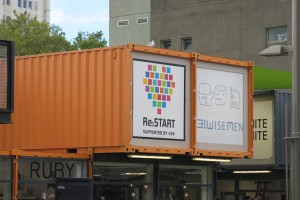
Nearly 30 businesses formerly in the city center now operate out of these colorful shipping crates in the Re:START village.

These timber arches are meant to house future outdoor markets around the city (they can be relocated anywhere).
And just when the lemon seems fully squeezed – even more citrus-y goodness!
After an early morning stroll through the massive and pretty Botanic Gardens, we made our way to the lovely farmers market, packed with fresh fruits, breads, veggies and meats and the people behind the tables couldn’t have been nicer. The guys at Bacon Bro’s Bacon Co. kept patrons laughing with a light-hearted schtick and when we didn’t have enough cash to pay for our fresh-from-the-farm pesto, the big-bellied (and bigger-hearted) proprietor tried giving it to us for free to remember Christchurch by.
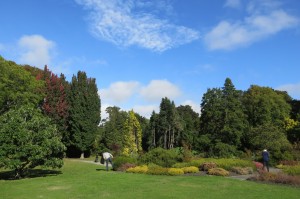
Christchurch was built as a model of class-structured England in the South Pacific meant to counter the typical colonial outposts (churches instead of pubs, etc). The Botanic Gardens are a remnant of this ideal – modeled after the English gardens so popular at the time.
And if you’re thirsty, make your way to Pomeroy’s, where one of the knowledgeable bartenders will let you sample one of the 31 craft beers on tap, or to the biker bar, Smash Palace, where they serve beer out of an old bus shell. Or grab a coffee at Addington Coffee Co-Op, where they’ll let you sit for hours on one of their sunny picnic tables. Our spirits were high as we packed our bags for the trip back over to the other side of the world.
Our time in New Zealand had drawn to a close, but first, to tie a big old red, white and blue bow on the whole adventure, we experienced our single detour through the US en route to South America, stopping for an extended layover in San Francisco. Coordinating the 36-hour stopover with one of my dad’s regular business trips out west meant some family time (and of course, another Marriott) as we played tourist in the beautiful City by the Bay.
To repeat: This was the one time in 365 DAYS that we would touch soil in the good old’ US of A. So clearly this meant one thing to Dave.
So, sufficiently fueled by rice, beans and shredded cheese, we strolled Fisherman’s Wharf for lunch and Pier 39 to see the seals, hiked to Lombard Street and out to the foot of Golden Gate Bridge and ate crab rolls, clam chowder and ridiculously delicious sushi until we’d proven to ourselves we still belonged.
Then we were off again. But the taste of home would sustain us for the last leg of our year-long trip around the world: South America!
(You’re still humming that damn Gotye song too, aren’t you?)
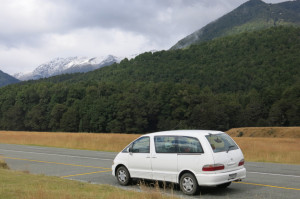 When you pack for a year in a backpack, you inevitably end up chasing summer for wardrobe’s sake. Lucky for us, it’s been an easy chase and we’ve caught it. Summer’s been hog tied and strung up to our backpacks for about 9 months straight (Noelle’s deceptively good with a lasso). Welp, apparently our luck had run out and we had to succumb to (gulp) fall-like conditions when we explored a couple natural beauties on New Zealand’s South Island – Milford Sound and Mt. Cook. Understandably, this admission will probably earn a lot of unsympathetic shrugs from our friends back home when they find out that this dip in the temperature for us meant that it dropped into the 40s for the first time in a long time.
When you pack for a year in a backpack, you inevitably end up chasing summer for wardrobe’s sake. Lucky for us, it’s been an easy chase and we’ve caught it. Summer’s been hog tied and strung up to our backpacks for about 9 months straight (Noelle’s deceptively good with a lasso). Welp, apparently our luck had run out and we had to succumb to (gulp) fall-like conditions when we explored a couple natural beauties on New Zealand’s South Island – Milford Sound and Mt. Cook. Understandably, this admission will probably earn a lot of unsympathetic shrugs from our friends back home when they find out that this dip in the temperature for us meant that it dropped into the 40s for the first time in a long time.
After Queenstown we had a lot of ground to cover in just a couple days in order to see two of the most popular natural sights New Zealand has to offer – Milford Sound and Mt. Cook.
Milford Sound is to New Zealand what the Grand Canyon is to the U.S. – an impressive natural sight considered a “must see” among its country’s residents that still manages to live up to the hype for just about everyone who sees it in person. Laying claim to being the most visited natural attraction in all of New Zealand, it’s the only one of 14 “sounds” (they’re all incorrectly referred to as sounds, but in actuality they’re fiords. Potato, potahto.) that’s accessible by road.
A picturesque drive through mountains, sheep farms and landscapes that extend seemingly forever in all directions – pretty much the norm everywhere in this country if that’s not apparent from our mention of these things in every post from this country so far – took us through Te Anau and on to our final destination. While all the drives have been great, this one had a little bit of everything. Rain, sunshine, mountains, lakes, rivers and, of course, sheep. Always the sheep and their “doo dah-doo, nothing to see here” blank stare into whatever object is closest to its eyes at that moment. (EDITOR’S NOTE: Enter another reminder that Dave loves farm animals. What is a wife to DO with this information?)
With plenty of waiting-to-be-seen turnoffs en route, it’s easy for the anticipation to build as the landscapes change and the clouds and mountains become more and more ominous the closer you get. A short, harrowing (if you’re in a minivan on its last legs and – as we found out on the fly – also on its last headlights) ride through the creepily dark, ¾-mile long Homer Tunnel, and you’re spit out toward Milford Sound – the pot of gold at the end of this concrete rainbow.
It’s common for visits to Milford to be marred by cloudy skies and rain (happened to me when I visited seven years ago) since the annual rainfall averages out to over one inch per day. But by some stroke of luck, me and m’lady woke up to a sunshiny day and clear skies for our boat cruise.
Milford comes complete with the imposing and photo-friendly Mitre Peak dominating the landscape. Rising more than a mile above the water’s surface, its thought to be one of the tallest mountains in the world to rise directly from the sea floor, hiding its 300+ meter base below the surface. The cruise was a no brainer for us to include on our tour de New Zealand, and taking in the rocky cliffs, a fur seal colony, the flora and fauna (two words you can never say enough) and everything else in the area played like a radio station with the best hits from the 80s, 90s and today. We sat on the dock of the bay sound, heard the skipper call “Come Sail Away” to us and like that, we were On A Boat. And then, despite repeated warnings to avoid pursuit of waterfalls, we opted to avoid familiar rivers and lakes and chased the countless falls around the sound.
Turns out world explorer extraordinaire Capt. James Cook didn’t even know about Milford for many years after exploring the coasts of New Zealand because unless you’re looking for it, it’s impossible to grasp it’s size and depth from the Tasman sea because of its curves. Which is to say Milford’s hips don’t lie.
From NZ’s Grand Canyon we set off to its highest peak – Mt. Cook, or Aoraki as it’s known to the Maori. In addition to being a much cooler sounding name, Aoraki translates to “cloud piercer,” which is just awesome. And after a day in the Aoraki National Park its clear to see how it got its name.
We encountered less-than-ideal conditions while we were there, but we waited out a few clouds to hike the Hooker Valley for some great landscapes of glaciers, and after our hike through the valley we saw ol’ cloud piercer earning its name with a few quick glimpses of the peak as we left the park.
Before making our way for the east coast, we set up camp just outside Lake Tekapo at the closest thing to a trailer park we encountered in the country. Picture this – we pull into town as the sun is setting, the one campground in town is full so we stumble across a chain-link gate that supposedly leads to another campground outside of town. About 5km later on a bumpy gravel road we pull into said trailer park where you can hear a pin drop. We’re talking there-might-be-a-sniper-in-the-trailer-next-to-us, creepy silence. So yeah, good luck sleeping. From the moment we arrived to the moment we left, the only signs of life we saw or heard were a pack of sheep that walked by in the morning. Ah, the great outdoors.
A small town in the middle of nowhere, Tekapo is a stargazer’s holy land. Go enter “Earth and Sky Tekapo” into the Googles and you’ll see that this place is world famous for its star-filled skies. We’ve seen some amazingly clear skies for stargazing this year, but all pale in comparison to this place. It’s actually designated as a dark sky reserve. I’m assuming you’re like us and had no clue such a thing even existed, but after a few seconds of letting your eyes adjust under the blanket of stars above here you’ll quickly understand the designation.
From Sound to stars with a little hill known as Mt. Cook in between, the scenery train it kept a rollin’. Quickly, our three weeks felt as if they’d gone by in three days. Could we really be on the last leg to return the van before leaving? Yes. The answer is yes. It was time to soak up the last few days of this glorious and gorgeous country in Akaroa and Christchurch.